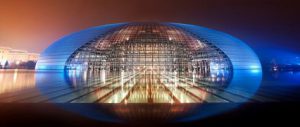Though still shrouded in scaffolding, the world’s second tallest building already overshadows its companions in the crowded Shanghai skyline. Located in the Pudong financial district, the Shanghai Tower’s spiralling trunk represents China’s emergence as an economic superpower. But the elegant shape has a more practical application: it works with the wind.
Designers refined the twisting, tapering form so that loads would be reduced by 24%. This allows the building to be unusually light, saving developers some £36 million. When completed next year the 632-metre tower, which cost an estimated £1.6 bn, will be an architectural showstopper.
In line with the aim to build the most sustainably advanced skyscraper in the world, Gensler, a global architecture firm, has made considerable innovations to earn the building both a LEED Gold standard and a China Green Building three star rating.
Comprised of nine vertical zones of 12-15 stories each, the “city within a city” will hold offices, housing, cultural facilities and commercial space. Cutting edge technologies include wind turbines at the building’s crown that produce 54,000 kWh/year in renewable energy, powering external lighting. Two curtain walls envelope the building, creating an air pocket to insulate in winter and cool in summer.
Locally sourced materials with a high-recycled content have been used where possible, and one third of the interior will be “sky garden” or public green space. There are more sustainable strategies, but in total the building’s carbon footprint will be reduced by 34,000 metric tonnes per year compared to a typical structure of the same scale, according to Gensler.
“Working with the client [the government], we are hoping that the Shanghai Tower sets a new international benchmark for environmental responsiveness,” says Grant Uhlir, the Principal of Gensler. “It’s an opportunity for [the government] to make a progressive statement to the world about sustainable strategies and they’re also looking at this tower to be a model for future development in China.”
Chinese cities are in desperate need of a new development strategy. Since 1980 the urban population has grown by 120%, while built-up areas have tripled. Reckless construction has not only rendered cities less livable, but has depleted natural resources and contributed to the country’s pollution woes.
China’s Twelfth Five-Year Plan (2011-2015) expresses leaders’ aspirations for more balanced development, and recently Premier Li Keqiang has stressed that future construction should be “scientific”. At the World Economic Forum in Dalian in September, Zhang Xiaoqiang, a high-ranking official, said: “Our urbanisation should embody the concepts of green, intensive, intelligent and low-carbon and it does not mean simply building things or enclosing land.”
However, there is debate about what constitutes a suitable “green” urbanisation strategy for China. Is it better to build vertical mega cities (as epitomised by the Shanghai Tower), to pursue the “hub-and-spoke” model, or to create an inter-connected network of small cities? Definitions of green constructions also range from “not as bad” as typical structures to living and breathing buildings that regenerate their surroundings.
Gensler argues that, for China, verticality is the sustainable strategy. And as symbols of prosperity, it’s unsurprising that China is partial to the addition of extravagant towers to its skylines. Seven of the ten tallest buildings currently being built are in China. The 202-storey Sky City in Changsha is aiming for a double distinction: to be not only the tallest skyscraper when it opens, but also the most rapidly built.
But developers should build upwards with caution. “There’s nothing inherently sustainable about a skyscraper,” says Daniel Safarik, an editor at the Council on Tall Building and Urban Habitat. “It takes an enormous amount of energy to run a building like [the Shanghai Tower]. You’ve got all the vertical transportation to deal with, all the mechanical systems, the amount of electricity needed to keep the lights on is pretty extraordinary.”
While the Shanghai Tower goes to great lengths to generate its own energy, the structure is supported by 1,079 concrete and steel bore pipes driven into the ground. A fleet of trucks pumped concrete for 63 hours to create the foundation. Time will tell, says Uhlir of Gensler, whether this building will achieve carbon neutrality.
“We have to think: what would the place look like if human beings had never set foot in it?” says Pius Leuba, director of the Biomimetic Design Lab (BiDL) at Tongji University, as he describes the optimum sustainable city model. “If Shanghai had never been populated, how much water would it clean per day, how much oxygen would it produce, how much top soil would it create? If our city could arrive to the same benefit, we would have a sustainable city.”
Given that Chinese urbanisation is distinguished by two characteristics – scale and speed – Leuba adds that cities should at least deploy the mixed-use neighbourhood model. Having apartments, offices, commercial and green spaces in close proximity reaps sustainable benefits, including land-use synergy (where residents become customers for retail which provides amenities to residents), increased access to public transit and more affordable smaller-unit housing.
“Of course ‘density’ has a bitter aftertaste because it sounds like ‘crowdedness’,” says Leuba. “This needs to be solved through design. It doesn’t necessarily need more energy or more resources if we can design smartly.” He points to Paris, with its low-rise, dense, mixed-use blocks as an example of a well-designed city.
Sustainable development also relies on context. “There’s a tendency to want to look at active systems, solar panels, things that move, turbines,” says Safarik. “But really, integration with the urban realm ends up being the most important metric…If you build a structure that draws other investment nearby, and you’re taking cars off the road and smaller offices spring up around it to provide services to the occupants, it starts to add to the credibility of the sustainable argument.”





